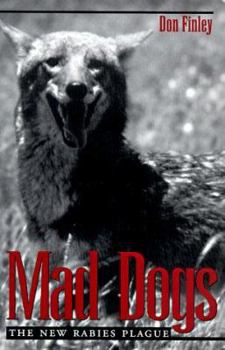Mad Dogs: The New Rabies Plague
(Part of the Louise Lindsey Merrick Natural Environment Series Series)
Select Format
Select Condition 
Book Overview
Rabies, one of humanity's most ancient and feared diseases, has swept through Texas in one of the most dangerous outbreaks in decades. Normally timid coyotes have become fearless, challenging ranch dogs twice their size, attacking an infant on her porch swing, menacing oil field workers. More ominously, they have infected hundreds of pet dogs, resulting in some fifteen hundred people in South Texas exposed to the dreaded disease. While South Texas copes with the effects of this outbreak, another has infected raccoons from Florida to New York, turning those toylike and benign creatures vicious. The United States, with the world's most complex rabies problems, seems helpless to resolve them--despite the fact Europe and Canada have mounted successful and ongoing oral rabies vaccination programs. Controversy remains over who will pay for a federally approved vaccine, since the United States considers rabies a local health problem, though the virus knows no state lines or international boundaries. In 1995, the USDA granted permission to drop an experimental, genetically engineered vaccine over nearly fifteen thousand square miles of South Texas brushlands in an effort to stop the spread of the disease. In Mad Dogs: The New Rabies Plague, Don Finley chronicles the epidemic, the politics of response to it, and the most ambitious American attempt yet to erect a barrier against the disease--in Texas. He tells the stories of those who have been plagued by rabies, and those who have accepted the charge to end the plague. Finley's straightforward language, free of either jargon or hysteria, is a welcome approach in describing the disease's destructive effects. His rare inside look into the politics and the science of disease control within public bureaucracies will engross those interested in science and public health issues, pet owners and wildlife enthusiasts, and those fascinated by infectious disease threats.
Format:Paperback
Language:English
ISBN:0890968225
ISBN13:9780890968222
Release Date:January 1998
Publisher:Texas A&M University Press
Length:232 Pages
Weight:0.90 lbs.
Dimensions:0.7" x 6.1" x 9.1"
Customer Reviews
1 rating
A good read for all
Published by Thriftbooks.com User , 26 years ago
The back cover of this book states, "His (i.e., the author's) rare inside look into politics and the science within public bureaucracies will engross those interested in science, public health issues, pet owners and wildlife enthusiasts, and those fascinated by infectious disease threats". This statement is true. Actually it is a 'good read' for anyone and falls into the same ilk (though not necessarily so good) as Watson and Crick's "Double Helix". For those interested in pure entertainment, the book makes good bedtime reading for the general public and scientist alike. In fact, this true story has enough human interest, petty personal politics, good guys and not so good guys, and institutional politics to have the makings of a politics/science soap opera. For those wanting to be informed or educated the book gives a good view as to how public health officials, both competent and incompetent, approach the control of a disease outbreak, whether it be real or potential. It is also instructive in general terms because it illustrates how political influence can interfere with proper public health measures. This should provide the general public with some insight into how disease control processes can be blocked by becoming political footballs (ala AIDS) which is, in itself, a significant contribution to having an informed public. Finally, for those interested in wildlife disease, especially beginning wildlife epidemiologists and managers, there is a concise history of wildlife rabies in North America and the means that have been used to control it. The book could be used as an introduction to wildlife disease courses because it touches or raises indirectly all of the problems that one encounters in the control and study of disease in wildlife, e.g., proper sampling, population estimates, and the effects of home range and animal transport on these, to name a few. However, the efficacy of the book as a source of scientific information would have been enhanced if the passages referring to epidemiological and scientific issues had been more expansive. In some instances, these issues were merely mentioned in passing. However this is not a major deficiency since it was not the intention of the author to produce a textbook. As a reader, the major negative of the book was that there were areas of repetition (intentional or poor editing?) and sometimes the author seemed to use chronology as an organizing principle and at others he used topics. The latter has resulted in some confusion, but perhaps this approach was necessary because of the difficult task of drawing a number of disparate events and personalities together into a common plot theme, not unlike an Inspector Frost, or P. D. James mystery.






